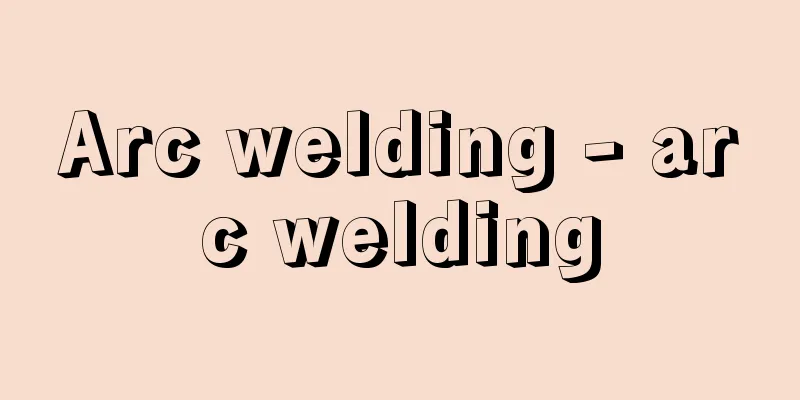Arc welding - arc welding

|
A method of joining metal materials by locally melting them using the heat of an electric arc. The temperature of an electric arc is 5000-6000K, making it a very effective heat source for melting metals. When metals are welded in the atmosphere, oxygen and nitrogen from the atmosphere dissolve into the molten metal, which often deteriorates the mechanical properties of the welded metal after solidification. Therefore, various methods are generally used in which the molten metal is isolated from the atmosphere by using a coating material or inert gas before welding. Shielded metal arc welding is a welding method in which an arc is generated between a covered electrode and the workpiece (base metal) to melt the electrode and the base metal. A covered electrode is a bare metal core coated with a coating made of organic substances, inorganic substances, deoxidizers, etc. Such coatings stabilize the arc and protect the weld metal from the atmosphere by the gas generated from the coating and the molten oxide (slag) layer formed by the coating itself melting. This method is the oldest and requires simple equipment, and is widely used to weld various steel materials, including structural steel, in various positions. This method is also called manual welding because it is generally operated by hand. Submerged arc welding is an automatic welding method in which a bare wire electrode is fed into granular flux piled up on the surface of the welded joint, generating an arc between the tip of the electrode and the base material, and performing continuous welding. The arc is covered by the flux and cannot be seen from the outside, hence the name. This method is very efficient as it allows welding with a large current, and the welding speed can be 3 to 6 times faster than that of covered arc welding. It is mainly used for welding large structures such as ships, steel pipes, storage tanks, and bridges. However, since granular flux is sprayed onto the joint, the welding position is limited. Inert gas arc welding includes TIG welding (non-consumable electrode type) and MIG welding (consumable electrode type). Both welding methods use inert gas such as argon or helium sprayed onto the weld, but TIG welding generates an arc between a tungsten electrode and the base metal. In this case, the tip of the tungsten electrode does not melt, but the tip of a rod-shaped filler inserted from the side melts and the base metal to perform the welding. When welding thin plates, no filler metal is required. MIG welding uses an electrode wire, generates an arc between the tip of the electrode wire and the base metal, and melts both at the same time. Inert gas arc welding does not require flux, so it can be used in any position and is highly efficient. It produces excellent quality welds and is suitable for welding metals that are easily affected by the atmosphere, such as aluminum, titanium, and zirconium. Carbon dioxide gas arc welding is a method of welding steel using inexpensive carbon dioxide gas instead of the inert gas used in MIG welding. Carbon dioxide gas is oxidizing at high temperatures, so a deoxidizing agent is added to the electrode wire beforehand. This method is performed in automatic or semi-automatic welding, but its use has recently expanded rapidly to welding mild steel and low-alloy steel in automobiles, ships, bridges, etc., replacing shielded metal arc welding. Stud welding is also a type of arc welding. In this method, a metal bar (copper, brass) up to 10 mm in diameter called a stud is placed in contact with the base metal, then the stud is moved slightly away from the base metal to generate an electric arc. When the tip of the stud and the base metal are properly melted, the stud is pressed against the base metal to weld it. No special coating or inert gas is used, but the end of the stud is surrounded by a ceramic arc shield and an arc is generated inside it. Recently, this method has been widely used in steel-frame construction. [Takeshi Kuwana and Zenshiro Hara] ©Shogakukan "> Arc welding ©Shogakukan "> Main types of arc welding Source: Shogakukan Encyclopedia Nipponica About Encyclopedia Nipponica Information | Legend |
|
電気アークの熱を利用し、金属材料を局部的に溶融して接合する方法。電気アークは温度が5000~6000Kであり、金属を溶融させるのに非常に有効な熱源である。金属を大気中で溶接すると、大気中の酸素や窒素が溶融金属の中へ溶け込み、そのため凝固後の溶接金属の機械的性質が劣化することが多いので、一般には、被覆剤や不活性ガスを用いて溶融金属を大気から遮断して溶接する、各種の方法が採用されている。 被覆アーク溶接は、被覆溶接棒と被溶接物(母材)との間にアークを発生させ、溶接棒と母材とを溶融させて溶接する方法である。被覆溶接棒は裸の金属心線の周りに有機物、無機物、脱酸剤などからなる被覆剤を塗布したものである。このような被覆剤はアークを安定させ、被覆剤から発生したガスおよび被覆剤自体が溶融して生成する溶融酸化物(スラグ)層によって溶接金属を大気から保護する。この方法はもっとも古くから発達したもので、設備も簡単で、構造用鋼をはじめ各種鋼材の各種姿勢での溶接に広く用いられている。この方法は一般に手で操作されるので手溶接ともよばれる。 サブマージアーク溶接(潜弧(せんこ)溶接)は、溶接継手の表面に盛り上げた粒状フラックスflux(被覆剤)の中へ裸の電極線を送り込み、その先端と母材との間にアークを発生させ、連続的に溶接を行う自動溶接法である。アークはフラックスに覆われて外からみえないのでこの名称がつけられた。この方法は大電流で溶接ができるので非常に能率がよく、被覆アークに比べ溶接速度を3~6倍以上にすることができる。おもに造船、鋼管、貯蔵タンク、橋梁(きょうりょう)など大型構造物の溶接に利用されている。しかし継手に粒状フラックスを散布するので、溶接姿勢が限定される。 不活性ガスアーク溶接としてはティグ(TIG)溶接(非消耗電極式)とミグ(MIG)溶接(消耗電極式)がある。両者とも溶接部へアルゴンやヘリウムなどの不活性ガスを吹き付けて溶接するが、ティグ溶接はタングステン電極と母材との間にアークを発生させる。この場合、タングステン電極の先端は溶融せず、側面から挿入した棒状の溶加剤の先端と母材が溶融して溶接が行われる。薄板を溶接する場合は溶加剤を用いなくてもよい。ミグ溶接は電極線を用い、その先端と母材との間にアークを発生させ、両者を同時に溶融させて溶接する方法である。不活性ガスアーク溶接はフラックスが不要なため、どのような姿勢でも高能率の溶接が可能である。溶接部の品質が優れており、アルミニウム、チタン、ジルコニウムなど大気の悪影響を受けやすい金属の溶接に適している。 炭酸ガスアーク溶接は、ミグ溶接の不活性ガスのかわりに安価な炭酸ガスを用いて鋼を溶接する方法である。炭酸ガスは高温で酸化性を示すので、あらかじめ電極線に脱酸性の成分を加えておく。この方法は自動あるいは半自動溶接で行われるが、最近、自動車、造船、橋梁など軟鋼、低合金鋼の溶接に、被覆アーク溶接にかわって急速に利用が拡大している。 スタッド溶接もアーク溶接の一種である。この方法では、スタッドstudとよばれる直径10ミリメートルまでの金属棒材(銅、黄銅)を母材に接触させておき、次にスタッドを母材から少し離して電気アークを発生させる。スタッド先端と母材が適当に溶融したとき、スタッドを押し付けて溶接させる。とくに被覆剤や不活性ガスは用いないが、陶器製のアークシールドでスタッドの末端を囲み、その内部でアークを発生させる。最近この方法は鉄骨建築に多用されている。 [桑名 武・原善四郎] ©Shogakukan"> アーク溶接による接合 ©Shogakukan"> アーク溶接のおもな種類 出典 小学館 日本大百科全書(ニッポニカ)日本大百科全書(ニッポニカ)について 情報 | 凡例 |
<<: Agura (seating equipment) - Agura
Recommend
Ergonomics - Ergonomics
…During World War II in the United States, resear...
Pym - John Pym
British politician. The most powerful opponent of...
ZAS
...The casting temperature is low at about 400°C,...
Huoshan - Kakuzan
A mountain in the western part of Anhui Province,...
Kawagoe House
… [Arai Toshiro] [history] In the Middle Ages, it...
Eating a meal - Kasshiki
〘Noun〙① ("Katsu" means to chant) In Zen ...
Government forest - Kanrin
Same as "government-owned forest." Sourc...
Ashikaga War Chronicles
A war tale that chronicles the upheavals of the Mu...
Carvalho
1560‐1631 A Portuguese Jesuit from Lisbon. He join...
Labor agreement - labor agreement
It refers to an agreement regarding working condi...
Went, FW (English spelling) WentFW
…Research from the late 19th century to the early...
Enmyokan
…Kan means a Taoist temple. Xuanmiao Temple in th...
trial jury
...It is a separate body independent of professio...
Minicoy Island
…A group of coral reef islands in the Arabian Sea...
Marsh, OC (English spelling) MarshOC
…With the development of the American West and th...








![Toyama [town] - Tomiyama](/upload/images/67cc5b3a38de1.webp)
